
Coffee is a very well known beverage worldwide, so there are many ways to prepare it.
Perhaps you have an ideal of the perfect coffee for your palate, however we want you to broaden your horizons with this guide of 11 ways to prepare coffee, in this guide we will talk a little about the method and level of difficulty to the flavours.
•French Press
•V60
•Aero Press
•Moka Coffee Maker
•Chemex
•Kalita
•Espresso Coffee Maker
•Siphon Coffee Maker
•Automatic drip coffee maker
•Cold Brew Coffee
•Turkish coffee
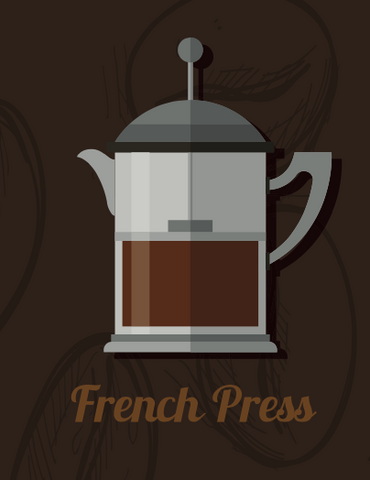
French Press.
The French press is one of the best known methods for preparing coffee, this method is based on immersion. It produces a characteristic flavour with a medium body, somewhat textured and a little earthy, although the earthiness can be eliminated by filtering it afterwards.
For its preparation, medium coarse ground coffee is added to the press, followed by boiling water AND depending on the quantities a rest of 3 to 5 minutes ready to serve by pressing the filter down.
Advantages:
Easy and practical preparation.
Strong and characteristic flavour.
Allows to fill several cups at the same time.
Cons:
Earthy texture with sediment.
Too much resting makes it bitter.
Press is not very portable.
Steeping is difficult to perfect.

V60.
Called V60 for its V shape and 60 for its 60° cone, it is a popular drip/soak method.
This device has a single drip hole for uniform filtration. This method of coffee extraction results in good aroma, body and a clean flavor profile.
Advantages:
The process is fast and of good quality.
It is easy to clean.
It can be purchased at a moderate price.
Cons:
Requires special mandatory paper filters.
Only makes one cup of coffee at a time.
Filter paper can spoil the flavour.
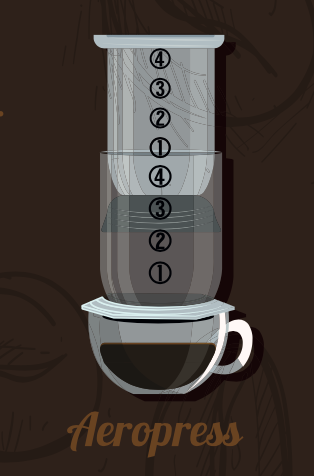
Aero-press.
Aero-press is a practical and simple device, it is a tool divided into 3 parts that allows you to make excellent coffee. This method is very popular for its speed and quality. The quality is achieved by the temperature of the water and the right thickness of the grind.
This device allows us to obtain a cold, normal and almost espresso coffee with a nice color and a clean and pure flavor.
This device consists of two plastic cylinders that act as a syringe attached to a paper or metal filter, which is pressed downward creating an air pressure on the mixture of water and filtered coffee until the cup is filled.
Advantages:
Lightweight.
Portable, such as for camping, hiking, etc.
Smooth and tasty result.
Quick to prepare.
Customisable.
Inexpensive.
Cons:
Uses only special paper filters.
Produces about two indexes per process.
Requires specialised equipment.
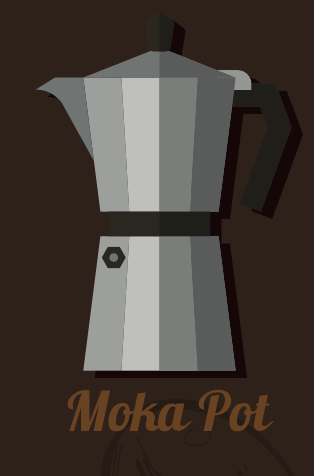
Mocha coffee maker.
The moka coffee maker produces a concentrated, tasty coffee with a light texture. It is quick to prepare. Water is poured into the brewing utensil and a fine bean is placed on the stove, boiling the water under pressure causing it to vaporise and condense through the coffee.
Advantages:
Easy to use.
Low cost.
Quick preparation.
Very good flavour.
Cons:
Requires specialised equipment.
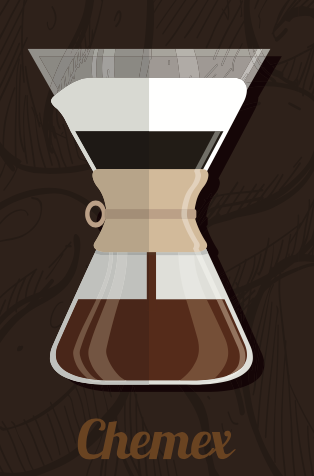
Chemex.
This glass utensil, unlike the v60 and other pour-over coffee methods, allows more than one cup per process. It requires a simple process by placing the paper filter over the chemex, the ground coffee is placed, water is heated in another container and poured over it to filter and fall into the container. With this method a lower body index is achieved, sweet and without residues or acidity.
Advantages:
Attractive design.
Up to 4 cups per process.
Quick and easy process.
Removes oils to obtain transparent cups.
Tasty and aromatic beer.
Cons:
Requires special filters.
Special paper filters are more expensive .
Glass coffee maker is not very portable .
Kalita.
It is another drip extraction method similar to the v60 with some differences. It has a flat bottom with three small holes and a wavy filter that affects the flow of water allowing it to accumulate at the bottom before the drip, the grind should be fine, this process can take about 3 minutes, in turn the cup is more consistent and tolerant.
With this method a coffee with more body and balance between acidity and sweetness is obtained.
Advantages:
Creates an excellent infusion.
Affordable.
Cons:
Requires special filters.
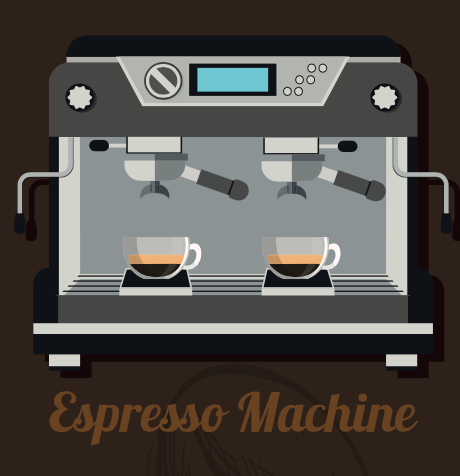
Espresso coffee maker.
Espresso machines are priced higher than a conventional coffee maker. Commercial machines take approximately 15 to 40 minutes to heat up giving an excellent espresso, but a domestic one takes only 3 minutes and once heated your cup of coffee will be ready in 30 seconds.
These machines propel hot water under pressure against a generally fine grind, however the automation varies depending on the machine, and to learn an excellent preparation method it is necessary to know or learn a little of the subject for the excellence of the beverage.
Advantages:
Wide range of prices.
Its infusion is concentrated and strong.
The process is fast once it is hot.
Cons:
Takes up space.
Needs constant maintenance.
Depending on the quality of the machine it will give you a good or simple espresso.

Siphon Coffee Maker.
This innovative coffee maker is a union of immersion and filtering technology, it uses vacuum induced by heat as a result the water is propelled upwards, in the upper chamber soaks the medium coarse ground coffee and through the drip provides a cup of smooth, clear and tasty coffee.
Advantages:
If well brewed it can produce one of the best flavours.
Impressive design and process.
Cons:
This method of preparation requires a lot of practice to achieve the preferred level.
Not recommended for transport, very fragile.
Difficult to clean.
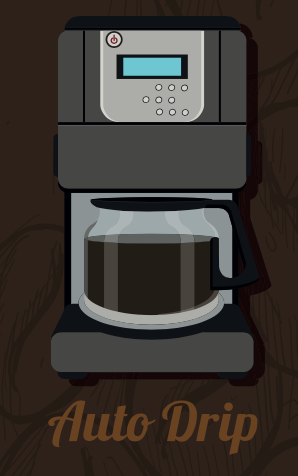
Automatic drip coffee brewer.
Percolator coffee brewers have a very similar operation to drip coffee brewers. Its process is simple, it only requires pouring water, pressing a button and it will begin to heat it and then it will fall through the ground coffee that rests on a paper, steel mesh or aluminium filter, resulting in a pure, full-bodied and very aromatic coffee.
This type of coffee maker exists in a great variety, for which a medium coarse grind is recommended.
Advantages:
Easy to use and generally automatic.
Prepares several cups at the same time.
Maintains the temperature for 1 or 2 hours.
Cons:
No professional flavour.
Many cups per process.

Cold Process Coffee.
The cold process is a way of preparing coffee by submerging the ground beans in cold or ambient water and this process can last from 10 to 24 hours, it is a simple process in its preparation but requires time. Generally a coarse grind is used. Since it is not heated, it becomes a slightly sweet beer with little acidity.
Advantages:
Strong flavor.
Slightly sweet and low acidity.
Easy brewing procedure.
No special equipment needed.
Cons:
Takes a long time to prepare.
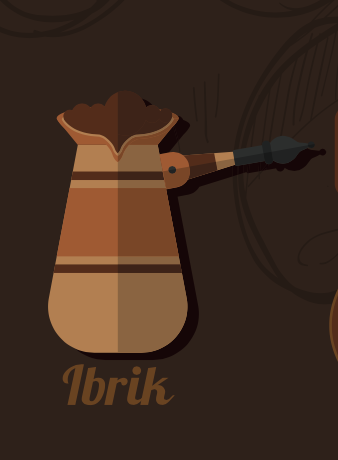
Turkish coffee.
This device is called cezve, in which water is poured, sugar to taste and mixed, brought to the fire to the boiling point and removed to place a very fine coffee, put to boil several times to the boiling point until the mixture is very frothy.
The result is a strong, tasty and very frothy drink.
Advantages:
Strong, dark drink with an attractive foam.
Cons:
Can be very strong.
Needs special equipment.
Written by Aaron Morales
Images used under licence from Shutterstock.com
Stock Vector ID 604445360
Stock Vector ID 1176656146
